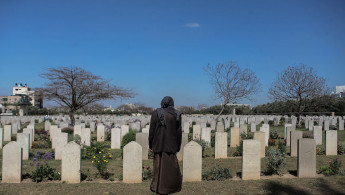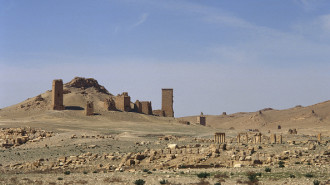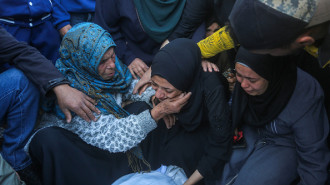Explained: What happened to Britain and Australia's Gaza war cemeteries?
Thousands of British imperial and allied servicemen and women from the First World War and the Second World War are buried in the Gaza war cemeteries, but the fate of these cemeteries and their caretakers amid Israel's war on the besieged Palestinian enclave has been mostly ignored by politicians and media.
The cemeteries have suffered damages from Israeli air and artillery strikes, according to satellite image evidence. Their caretakers have had to flee or are unaccounted for as Israel has killed over 38,000 civilians in Gaza with tens of thousands more injured or missing.
Until October 7, local staff and communities had preserved the war cemeteries for some 100 years, under the auspices of what is now known as the Commonwealth War Graves Commission.
The Gaza War Cemetery, in eastern Gaza City, holds over 3,600 burials and memorials. In central Gaza, near Az Zawayda, the Deir El Belah Cemetery contains over 700 British war dead.
There is also a mass burial site for Egyptian labourers nearby.
Why are British and Allied soldiers buried in Gaza?
The majority of the casualties are from 1917, when British imperial forces fought three battles to break Ottoman defences to capture Gaza, entering a devastated Gaza City on 7 November 1917.
From there, they took Jerusalem by the end of the year. The war dead were collected from the battlefields and buried in the new cemeteries, with many never identified. There are a number of Jewish headstones in the cemeteries, an Ottoman section and Indian sections for several Muslim, Hindu and Sikh men, mostly from Punjab.
During the Second World War, Britain had an RAF aerodrome in Gaza and there was an Australian base with a number of hospitals. 210 burials in the Gaza War Cemetery are from this time, including two female medics, Lt. Jean Gay and Maria Kloc of Australian and Polish forces respectively. The cemetery was enlarged between 1956 and 1967 for Canadian and Indian burials and memorials for casualties of the UN Emergency Force (UNEF), deployed with the permission of Egypt, at first to administer the Gaza Strip but, after protestations of Palestinians, as a buffer force between Egypt and Israel.
Overlooking the monuments in Gaza War Cemetery, dedicated to men and women from across the world, is a stone inscription referencing the local people. It states: “The land on which this cemetery stands was the free gift of the people of Palestine for the perpetual resting place of those of the allied armies who fell in the war of 1914-1918 and are honoured here.” It is repeated in Arabic and Hebrew and is the same inscription found in the Jerusalem War Cemetery.
Gaza war cemeteries has been a home to the staff and place of education and escape for Gazans under occupation, blockade and subjected to frequent devastating military assaults. School groups conducted tours, families would picnic on the neatly clipped grass, amongst trees and flowers, couples would go for walks and children utilised the generator-powered lights to do their homework during blackouts.
How did the war affect the cemeteries?
These sites now lie abandoned and in partial ruins, in a sea of destruction, since the escalation of conflict from 7 October, last year.
Staff, including Head Gardener, Ibrahim Jaradah Jr, who is of the fourth generation of his family to care for war graves in Palestine, fled Gaza City around the time of Israel’s evacuation notice for northern Gaza, on 13 October. Annual Remembrance Day ceremonies in November were cancelled and, after nine months of war, there are few indications that they will occur this year, as Israel’s military assault continues to be backed by the US, UK and other Western allies.
Satellite and on-the-ground images from January of this year showed that both Gaza war cemeteries had suffered damage, including headstone, wall, ground and tree destruction. However, they were being protected from the razing, including the digging up of turf and cadavers, inflicted by Israeli soldiers on Palestinian cemeteries.
But the Indian and Ottoman sections of the war cemeteries, for Muslim, Hindu and Sikh burials, appeared sandy coloured in satellite images, suggesting that they had been turned over by heavy vehicles, like much of the surrounding neighbourhood. The Canadian UN section also appeared severely damaged or destroyed.
More recent satellite images, from June, show that the Gaza war cemeteries still survive amid great devastation. The outer sections are destroyed, as is the house of the head gardener. A recent account suggests that Israeli forces are guarding access to the war cemeteries. I
In January, Israeli forces performed prayers at a Jewish grave, marked by a Star of David, in Deir El Belah War Cemetery. Lt Col. Oren Schindler told Israeli media: “We did not check if there was an underground tunnel under the cemetery because we did not want to harm its sanctity.”
Settler groups in Israel, meanwhile, who are supported by key Israeli ministers, have issued a map of Gaza renaming areas within the territory. The Al-Tuffah district of Gaza City in which the Gaza War Cemetery lies is renamed after the Jewish Legion or Hagdud Ha-Ivri, in honour of the British Jewish men from the First World War buried there.
Why are the UK, Canada, and Australia silent?
Since the escalation in conflict began, relatives of casualties buried in the Gaza war cemeteries have expressed concern for the Palestinian caretakers. Dave Cole had been in online contact with Ibrahim Jaradah Jr as part of his research into a relative killed in Gaza in 1917 serving with the 54th (East Anglian) Division. He told The New Arab recently: “I'm of the understanding that their homes and the British cemetery are damaged but I've seen no official reports. We are all grateful that they are safe and for the work they've done for the war graves.”
Cole's great-grandparent's cousin, Private John Saunders, is buried in Gaza. He served with the 163 Brigade, 54th (East Anglian) Division and the 4th Norfolks. He died during the Second Battle of Gaza on 20 April 1917.
But there has been little Western media interest in the fate of the Gaza war cemeteries or their staff. The Commonwealth War Graves Commission (CWGC), which looks after the sites, acknowledged unspecified damage, stating: “The welfare of our colleagues and their families is our clear priority and we remain in regular contact with them. We are saddened by the recent damage to the Gaza War Cemetery and Deir El Belah War Cemetery, and when it is safe to do so, we will assess what future repairs will be needed.”
In early May the CWGC broke a prolonged silence, as Israel launched its ground invasion of Rafah, including taking control of the Rafah Crossing, to announce that its Gaza team had been evacuated to Egypt, with “immediate families,” where they would remain and work for the foreseeable future, after a period of rest and recuperation.
A week later, on 14 May, then Defence Secretary, Grant Shapps, stated in a debate during Parliament’s “War Graves Week,” that five of the six Gaza staff of the CWGC had entered Egypt.He said: “I am heartened to confirm that just last week, five of the commission’s six staff who wanted to leave made it safely to Egypt, along with their immediate families, where they will join the commission’s in-country staff until it is safe for them to return.”
The remaining individual may be Yacoub Ismali, a gardener in, approximately, his fifties, who featured in CWGC media in early 2023.
The CWGC refused to comment when asked about the unaccounted-for member of their Gaza team. The UK Ministry of Defence (MOD) replied to a query from The New Arab to state that the CWGC is responsible for the war graves and sits outside of the government.
In early July, Greens Senator, David Shoebridge, broke the political silence in Australia to raise questions about the Australian war graves in a Senate committee meeting. A government spokesperson referred to a March report from CWGC, saying: "They (CWGC) acknowledged that the Gaza war cemetery had suffered some damage and the head gardener's house had been destroyed. We have not received any additional information since that time in March.” The spokesperson confirmed that Australia had not made any enquiries with Israel on the matter.
What happened to the caretakers?
As well as gardener Yacoub Ismali, the situations of two former Gaza team leaders are also unclear. Essam Jaradah was the Head Gardener prior to his retirement and the handing of his duties to his son, Ibrahim Jaradah Jr. Mohammed Awaja had a decades-long connection with the smaller Deir El Belah War Cemetery and had, in the past, worked alongside family member, Khalil Awaja, on the site.
The Jaradah family have worked at war graves for some 100 years, starting with Rabie Jaradah, in the 1920s when he lived in Beersheba, now in Israel. During the time of the 1948 Nakba, when Britain withdrew and Zionist forces established the state of Israel, the Jaradahs were amongst the over 700,000 Palestinians forced to flee their homes. Rabie Jaradah settled his family in Gaza and a member of his family has worked at the Gaza war cemeteries since.
Rabie Jaradah was succeeded by his son, Ibrahim Jaradah Sr., whose lengthy service at Gaza war cemeteries, from the late 1950s into the new century, through numerous conflicts, earned him an MBE. He protected the site during frequent escalations in violence, including when vandals attacked headstones in 2004 and Israeli bulldozers attacked the cemetery in the summer of 2006.
The cemetery was also badly damaged by Israeli forces again in 2008/9, with over 350 headstones damaged and the ground scorched by white phosphorus. Ibrahim Jaradah Sr. and his team repaired and restored the sites, even as major assaults were renewed and the blockade made accessing materials, tools and training much harder. The CWGC is known to have received financial settlements from Israel for the restoration of the Gaza war cemeteries after the damage in 2006 and 2008/9, which was unavailable for the rest of the territory.
Ibrahim Jaradah Sr welcomed a wide range of visitors and dignitaries at the Gaza war cemeteries, from the Archbishop of Canterbury and political representatives to the staff of NGOs and groups of local schoolchildren. Numbers of visitors from outside the territory, especially descendants of those buried in the cemeteries, receded after the imposition of blockade in 2007, by Israel and Egypt.
Before he died in May 2017, having been succeeded by his son, Essam and his grandson, Ibrahim Jaradah Jr, Ibrahim Jaradah Sr. continued to serve as an unofficial caretaker and advisor for the cemetery and was reported to spend time there using a Zimmer frame to get around.
He told a journalist in 2015: “I started at the age of 18 and will ensure that my grandchildren care for it too. The cemetery is a place of comfort for me, it has become part of the family soul, and will remain so.”




 Follow the Middle East's top stories in English at The New Arab on Google News
Follow the Middle East's top stories in English at The New Arab on Google News

![A group of Palestinians, foreign and Israeli activists gather to participated in an olive picking event on the land in the town of Battir, which is under threat of confiscation by Israel in Bethlehem, occupied West Bank on 8 November 2024. [Getty]](/sites/default/files/styles/image_330x185/public/2182930803.jpeg?h=199d8c1f&itok=__0LgGsa)
